The first organized Fire Department was setup in Boston after a large fire in 1679. This led to the organization of the first paid fire department in America. The city of Boston employed a chief and twelve firefighters. The first volunteer Fire Company was formed in Philadelphia, PA in 1736 and Benjamin Franklin served as America’s First volunteer Fire Chief.
The style of the Fire House has been constantly changing. After the Revolutionary War, better and many different styles of firehouses were built. The classic old firehouse was designed to hold a lot of older equipment and horses.
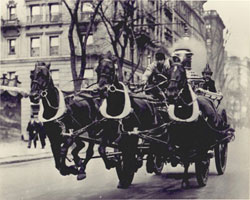
Fire horses came in three classifications:
* The lightweight: 1,100 pound horses that were used on the hose wagons,
* The middleweight: 1,400 pound horses that were used on the steamers, and
* The large, 1,700 pounders that were used to pull the hook and ladders as well as other heavy equipment.
Fire horses required a lot stamina, strength and natural ability. One expert of the time said it was usually a one-in-a-hundred selection. Horse training took between one and two years. The City of Detroit actually had a horse college where horses were trained. These where smart horses and it is said they could smell their way to a fire.
The fire pole was, a tradition in almost every fire department, it was invented in Chicago. The original purpose was to reduce the time it took firefighters to get from the second floor of firehouses (where firefighters lived and slept) down to the ground (where their equipment was). Nowadays, they are not used very often, but are usually still installed for tradition's sake.Fire houses were also equipped with spiral staircases so the horses would not try to climb the stairs into the living quarters Spiral staircases were difficult to descend and relatively slow when moving many men down to the wagons. The slide pole was a much more efficient way to move them quickly downstairs.
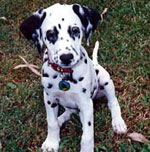 Nearly every firehouse had a resident Dalmatian dog. The job of the Dalmatian was to direct the horses, keep the horses company and guard the firehouse. When the fire bell sounded, the Dalmatians would run out of the firehouse, to let people know that they should get out of the way because the horses would soon be coming out. They would run along side of the horses and then help calm the horses at the fire site and also guard the fire wagons. Today fire stations do not keep horses, but many firehouses still have a Dalmatian. The resident Dalmatian is still responsible for guarding the firehouse and the fire trucks. It is not true that Dalmatians are kept at firehouses because they're deaf and therefore, the siren does not bother their ears nor make them "spook" like it would other dogs. Dalmatians do tend to suffer from deafness, but that has nothing to do with their firefighting abilities or why they where chosen for the job.
Nearly every firehouse had a resident Dalmatian dog. The job of the Dalmatian was to direct the horses, keep the horses company and guard the firehouse. When the fire bell sounded, the Dalmatians would run out of the firehouse, to let people know that they should get out of the way because the horses would soon be coming out. They would run along side of the horses and then help calm the horses at the fire site and also guard the fire wagons. Today fire stations do not keep horses, but many firehouses still have a Dalmatian. The resident Dalmatian is still responsible for guarding the firehouse and the fire trucks. It is not true that Dalmatians are kept at firehouses because they're deaf and therefore, the siren does not bother their ears nor make them "spook" like it would other dogs. Dalmatians do tend to suffer from deafness, but that has nothing to do with their firefighting abilities or why they where chosen for the job.
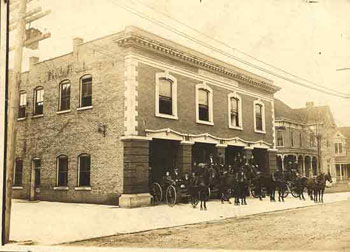
By the turn of the century, fire engines took the form of horse-drawn or automobile versions with hand water pumps mounted on the back. The first fire engine was in fact used by the Cincinnati fire department in the 1850's. These represented a big shift from earlier methods of fighting fires, including bucket lines. Still, they looked nothing like modern fire engines or even those that would appear by 1900. Most engines of this era were found in urban cities and had a unique design, as they where usually made locally by small manufacturers.
Not only were there countless fire apparatus manufacturers, but there were also many competing departments in most cities of this early era. Until professional departments were developed, these volunteer brigades often fought against each other, trying to outdo each other by obtaining the biggest and best fire engines. Because red was the most expensive paint color, most crews ended up painting their trucks red, a tradition that stuck. The color red was also chosen because of the stark contrast with most early cars, which were black.
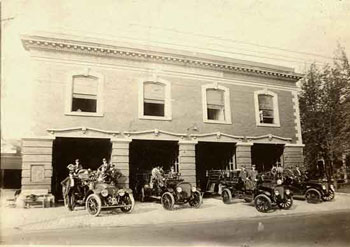 By the turn of the century, fire trucks became more and more necessary as many towns switched from volunteer to professional fire departments. Crowded cities required newer technology with efficient water pumps that were more mobile than previous steam-driven fire engines. Still, many smaller fire departments continued to use steam powered fire engines until as late as 1920. In fact, the term "fire truck" did not come to replace the earlier "fire engine" or "fire apparatus" until the 1930's. However, by 1910 to 1920 motorized fire trucks became commonplace in most cities.
By the turn of the century, fire trucks became more and more necessary as many towns switched from volunteer to professional fire departments. Crowded cities required newer technology with efficient water pumps that were more mobile than previous steam-driven fire engines. Still, many smaller fire departments continued to use steam powered fire engines until as late as 1920. In fact, the term "fire truck" did not come to replace the earlier "fire engine" or "fire apparatus" until the 1930's. However, by 1910 to 1920 motorized fire trucks became commonplace in most cities.
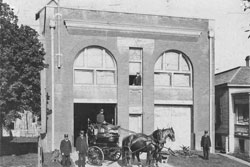 Old firehouses are still around today. The old firehouses were very sturdy and many of them still stand today. Many of these firehouses aren't used as firehouses today for two reasons. Either they are too small to keep modern equipment or too big to heat and cool.
Old firehouses are still around today. The old firehouses were very sturdy and many of them still stand today. Many of these firehouses aren't used as firehouses today for two reasons. Either they are too small to keep modern equipment or too big to heat and cool.
Fun Facts:
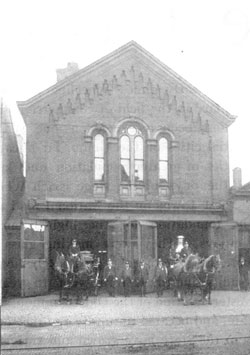 Fire sprinkler systems have been putting out fires since 1860. Although there have been some design improvements, the basic technology has remained the same for over 130 years. Most recently, fire sprinklers have started to appear in single family homes.
Fire sprinkler systems have been putting out fires since 1860. Although there have been some design improvements, the basic technology has remained the same for over 130 years. Most recently, fire sprinklers have started to appear in single family homes.- Fire "Plugs" or hydrants, got their name from one of the first municipal water systems. The system was made of wooden logs, and when there was a fire, FF would drill a hole in the loge to get water for the fire. When they were done, they would simply "plug" them up.
- A "pipe man" or "nozzle man" is a firefighter who's job is to put water on the fire.
- Firemen respond to an alarm of a fire somewhere in the United States every 16 seconds.
- Back in the early days when cars first appeared on the roads, they were all black. So to help clear the roads when a fire truck was coming through, they painted them red so they would stand out.
- "Truckies" are the firefighters assigned to a ladder truck and they're usually responsible for forcible entry, search & rescue, ventilation, salvage & overhaul.
- Someone is injured by fire about every 20 seconds.
- "Steamers" were the first fire engines. They used steam power to build up pressure to flow water through hoses. Now days the "steamer" is the large inlet on the side of a engine to let water into the pump.
- The internal combustion fire engines where first used in 1907, by 1925 the old steam engines had completely disappeared.
- More than two million career and volunteer firefighters serve in more than 50,000 departments throughout the United States.
- Benjamin Franklin is credited with being the "Father of the Fire Service" for his salvage operations during a fire.
- Before the invention of the horse drawn fire engine, fires were controlled by a "bucket bigade". A line of people passing water in buckets down a line to extinguish a fir and then back again to refill the buckets.
- A "backdraft" is a real occurrence, not just a movie. When all the available oxygen in a room is consume by a fire, and the heat builds up, as soon as a door or window is opened, BOOM, you get a backdraft.
- Unlike fires in the movies, the smoke from a house fire can be so thick that your house
would be completely dark in 4 minutes, even with all the lights on! - The three most common types of fire trucks are pumper trucks, tanker trucks, and ladder trucks.
- The fire-bucket ordinance of 1835 in Chicago required every occupant or owner of a store or dwelling "to have one good painted leather fire-bucket, with the initials of the owner's name painted thereon" for each fireplace or stove in the building, the bucket to be hung within easy reach.
- The first horse-drawn steam engine for fighting fires was invented in 1829, but not accepted in structural firefighting until 1860.
The reason firehouses have circular stairways is from the days when the fire engines were pulled by horses. The horses were stabled on the ground floor and soon figured out how to walk up straight staircases.
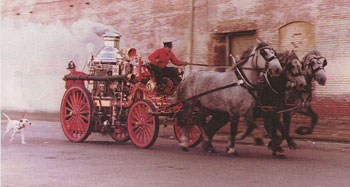 Sources:
Sources:
